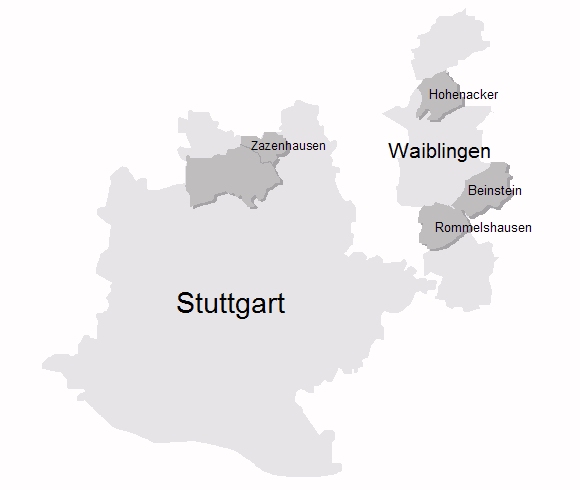|

The history of the Guelphs town Waiblingen is reported in the website of the city (see below*, but only in German language). In extracts can be gathered:
The Guelphs town
Waiblingen has a famous history. The name "Waiblingen" is reported in Carolingian documents four times in the years 885 and 887. Waiblingen are under the old towns of Württemberg which have been in possession of the "Counts of Wirtemberg" not later than in the middle of the 13th century. Therefore the oldest signet of the town from the year 1291 shows the emblem of the Counts of Wirtemberg, three rods of a deer antler lying one upon the other.
In connection with the historiography of the "Staufer" the biographer of Friedrich III Barbarossa (Duke of Swabia (1147-52), King of Italy (1154-86), King of Germany (1152-90) as Friedrich I, Emperor from June 18,1155, crowned in Rome, Comte de Bourgogne (1156-90), King of Bourgogne 1178) bishop Otto from Freising (1111/14 to 1158) referred to the Salian Emperors which are the ancestors of the Staufer and shows the relationship with the name Waiblingen. Otto von Freising: "In the roman empire there are two famous families in the region of Gallia and Germania, one was the family of'Heinriche von Waiblingen', the other the Guelphs of Altdorf. From the one emperors were breeded, from the other great Dukes"
The Salian Emperors, the "Heinriche von Waiblingen", owned inherited land in the valley of the Rems and in Waiblingen, this estate can be traced back until the Carolingian. The Salian king and emperor Konrad II (990 to 1039) was born in Waiblingen. According to the middle age chronicle "Reinhardsbrunner Chronik", in which is reported on a Benedictine monastery founded in 1085 in the region of Erfurt/Thuringia, the monks noted in 1025: "The Salian Konrad frankonian provenance is born in the town, which is called Webelingen .... Due to the marriage of the Staufian Duke Friedrich I with the Salian emperor's daughter Agnes the Staufers got the Carolingian-Salian heritage which included the region around Waiblingen.
There exist a tradition in Waiblingen since many years which implicates the Staufer party. Still today the Staufian ally were named "Ghibellini" compared to the "Guelfi" the Guelfian party supporter. The ancient battle cry "Hie Welf!" - "Hie Waibling!" is referred to the competition between Staufer and Guelphs"
A direct evidence of the importance of Waiblingen in Wirtenberg in the Middle Ages supplies the "contra" foundation of Neustadt ("Nova Civitas") in 1297, which should weaken Waiblingen. In the empirial war Waiblingen has been destroyed. The Town became wirtembergian not until 1315, after has been supposed the time before to the imperial city Esslingen at the Neckar. 6 years later the Wirtembergian moved their tomb from Beutelsbach/Remstal to Stuttgart and enlarged Stuttgart. For this reason Waiblingen lost the chance to establish itself as wirtembergian capital. At the begin of the 15th century Waiblingen became residence and old-age residence of members of the noble family of the wirtembergian Counts and subsequent Dukes as other comparable wirtembergian towns. In the ancient building of the Wirtemberger, where today the town hall stands, sons of the counts lived with their families, countesses spent their remaining years.
During the Thirty Years' War Waiblingen was burnt down completely in 1634 beside few house, the inhabitants were killed or displaced by soldiers. The reconstruction of Waiblingen protracted more than 150 years til the town was as before the destruction.
The largest city of today's Rems-Murr-Kreis was always a center of administration, once from the middle of the 13th century as domicile of Counts and Dukes, then beginning with 1759 as "Oberamtsstadt" (Capital of an administrative district). At that time the small administrative district consisted of about a dozen villages. Beginning with the 19th century the "Hintere Amt" Winnenden was added. When in 1923 the larger administrative district Cannstatt was dissolved, the Württembergian Parliament decided to add the communities Fellbach, Öffingen, Rommelshausen, Schmiden and Stetten to the larger administrative district Waiblingen. During the reform of the counties (administrative districts) in 1973 Waiblingen remained capital of the new and increased administrative district Rems-Murr-Kreis which consists now of the former districts Waiblingen, Schorndorf and Backnang.
|